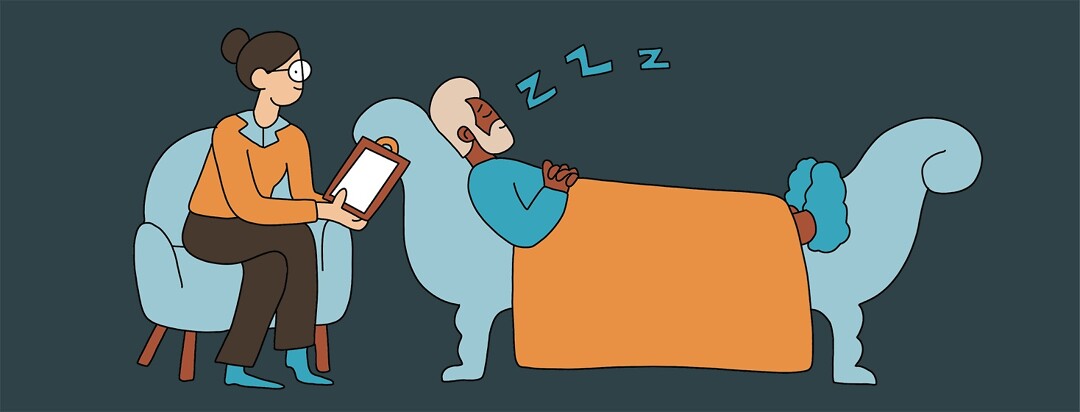Brief Behavioral Therapy Helps People with Lung Cancer Sleep Better
The roadblocks to sleep are many for people living with and treating lung cancer, and even beyond its survival. If it’s not insomnia that’s making sleep at night a nightmare, it’s the disruption to the circadian rhythms by medications or cancer itself, or it’s that relentless cancer-related fatigue.
Often, cognitive behavioral therapy for insomnia (CBT-i) is recommended as an approach for cancer patients seeking more and better sleep. And for good reason: CBT-i can be extremely effective in treating sleeplessness in people dealing with cancer. However, concerns about finding practitioners trained to deliver CBT-i is a common obstacle.1 There are simply not enough psychology-based providers to serve the whole of the insomnia population.
Take heart: There’s another option that may be available to people with lung cancer: brief behavioral treatment of insomnia (BBT-i).
What is Brief Behavioral Treatment of Insomnia?
Brief behavioral treatment for insomnia (BBT-i) describes a kind of abbreviated behavioral treatment option that can be delivered by a trained health professional who doesn’t have psychology credentials.
It’s typically composed of four sessions. (Previously, these were delivered as face-to-face sessions, but they’re more likely to be delivered by telephone or telehealth link online during the pandemic.) The sessions may vary in length, from 20 minutes on the phone to up to an hour in a telehealth meeting.
Unlike CBT-i, which incorporates more sophisticated techniques that require a board-certified psychologist for delivery, BBT-I is easily delivered by healthcare professionals with a modicum of training in the therapy, such as nurses and health coaches.2
However, BBT-i resembles CBT-i in two key approaches it employs to curb insomnia:
- Sleep restriction: These limits are “prescribed” as “time spent in bed” plus no more than 30 minutes, in order to improve sleep efficiency.
- Stimulus control: This is the practice of developing clear and positive associations between bed and sleep.
Likewise, sleep hygiene best practices are urged in both treatments, as they can eliminate some of the typical barriers to sleep. These include avoiding stimulating medications or caffeine products, skipping screen usage right before bedtime, or eliminating late afternoon naps, among other things.
BBT-i has been shown to be effective in reducing all of the facets of insomnia, including problems with:
- delays in falling asleep
- unwelcomed periods of wakefulness after falling asleep
- sleep inefficiency (spending too much time in bed awake)
But even if BBT-i may be seen as a form of CBT-i “Lite,” make no mistake: it’s effective. Some research indicates that BBT-i may even lead to full remission from insomnia.1
How does BBT-i stack up against other kinds of non-drug approaches?
Most people seeking out these therapies are hoping to avoid the use of sleeping pills. Other kinds of approaches for achieving better sleep usually reflect relaxation and mindfulness practices.
Recently, research was published that compared the use of BBT-i against progressive muscle relaxation training (PMRT) in veterans with insomnia.3 The doctors looked at sleep-related outcomes as well as other secondary outcomes that reflect concerns familiar to people with cancer:
- mood dips
- cognitive dysfunction
- pain
The results from that study showed that the individuals who completed the BBT-i sessions enjoyed “greater improvements in work, home, social and cognitive functioning, insomnia symptom severity, mood, and energy” compared to those who practiced PMRT. Not only that, but these improvements were still apparent six months after treatment was completed.
Other research confirms positive results of the BBT-i intervention in older adults facing challenges with insomnia, mood disorders, and cognitive dysfunction.4 In that study, the participants underwent four weekly sessions that included the use of a sleep diary and a wearable device to mark periods of nighttime activity to confirm sleeplessness. That study showed BBT-I to be extremely useful in reducing their insomnia symptoms.
The impact of BBT-i on lung cancer survivors
Current research that's focused on insomnia treatments for lung cancer survivors also bears out the promise of BBT-i.5
Insomnia is a problem for between 50 and 80 percent of all lung cancer survivors. However, finding a trained psychology professional to deliver CBT-i is a frequent deterrent for many people with post-cancer survival insomnia.
In one study, researchers introduced BBT-i as a modified, accessible approach to see whether it might support the sleep needs of these people. Participants were survivors of stage 1 and stage 2 non-small cell lung cancer dealing with chronic insomnia.
After using BBT-i approaches delivered by specially trained nurses, 85 percent of the participants enjoyed improvements to their sleep efficiency. The researchers concluded that the BBT-i approach could serve as a practical intervention to improve both the sleep and the quality of life of lung cancer survivors struggling with insomnia.
Want to discuss more about sleep troubles?

Join the conversation